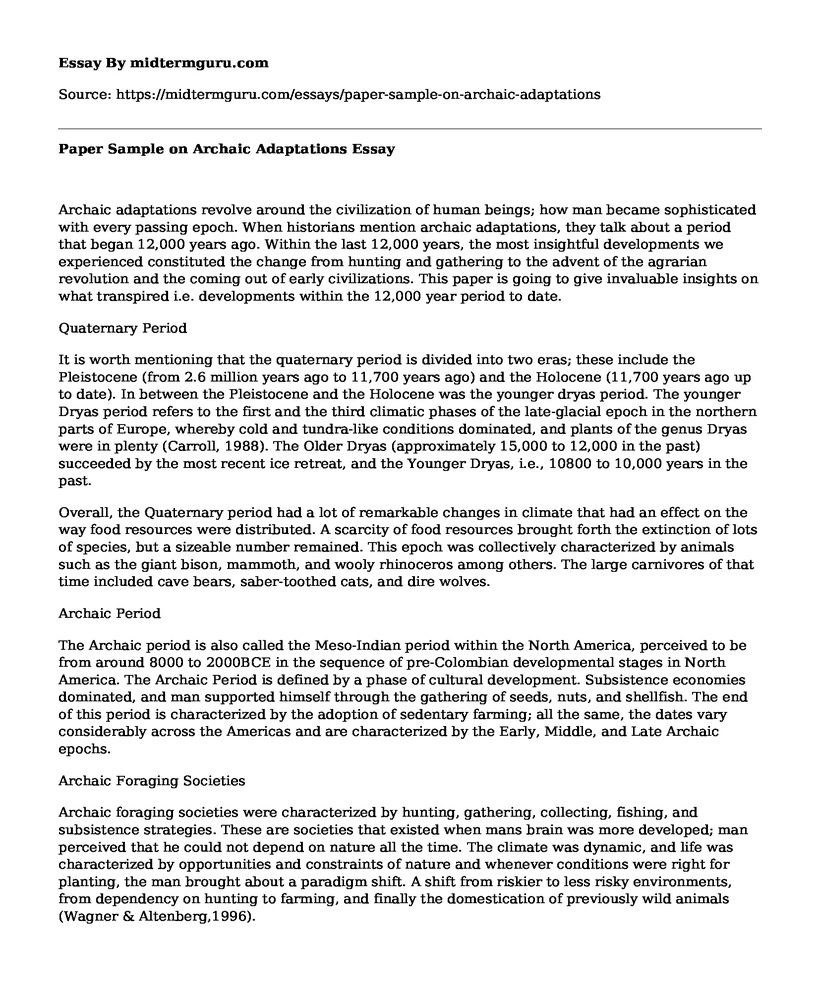Archaic adaptations revolve around the civilization of human beings; how man became sophisticated with every passing epoch. When historians mention archaic adaptations, they talk about a period that began 12,000 years ago. Within the last 12,000 years, the most insightful developments we experienced constituted the change from hunting and gathering to the advent of the agrarian revolution and the coming out of early civilizations. This paper is going to give invaluable insights on what transpired i.e. developments within the 12,000 year period to date.
Quaternary Period
It is worth mentioning that the quaternary period is divided into two eras; these include the Pleistocene (from 2.6 million years ago to 11,700 years ago) and the Holocene (11,700 years ago up to date). In between the Pleistocene and the Holocene was the younger dryas period. The younger Dryas period refers to the first and the third climatic phases of the late-glacial epoch in the northern parts of Europe, whereby cold and tundra-like conditions dominated, and plants of the genus Dryas were in plenty (Carroll, 1988). The Older Dryas (approximately 15,000 to 12,000 in the past) succeeded by the most recent ice retreat, and the Younger Dryas, i.e., 10800 to 10,000 years in the past.
Overall, the Quaternary period had a lot of remarkable changes in climate that had an effect on the way food resources were distributed. A scarcity of food resources brought forth the extinction of lots of species, but a sizeable number remained. This epoch was collectively characterized by animals such as the giant bison, mammoth, and wooly rhinoceros among others. The large carnivores of that time included cave bears, saber-toothed cats, and dire wolves.
Archaic Period
The Archaic period is also called the Meso-Indian period within the North America, perceived to be from around 8000 to 2000BCE in the sequence of pre-Colombian developmental stages in North America. The Archaic Period is defined by a phase of cultural development. Subsistence economies dominated, and man supported himself through the gathering of seeds, nuts, and shellfish. The end of this period is characterized by the adoption of sedentary farming; all the same, the dates vary considerably across the Americas and are characterized by the Early, Middle, and Late Archaic epochs.
Archaic Foraging Societies
Archaic foraging societies were characterized by hunting, gathering, collecting, fishing, and subsistence strategies. These are societies that existed when mans brain was more developed; man perceived that he could not depend on nature all the time. The climate was dynamic, and life was characterized by opportunities and constraints of nature and whenever conditions were right for planting, the man brought about a paradigm shift. A shift from riskier to less risky environments, from dependency on hunting to farming, and finally the domestication of previously wild animals (Wagner & Altenberg,1996).
Summary
Archaeologists believe that the earliest people to exist are the Paleo-Indian who lived in Asia and later migrated to South America before Pangea broke up into bits; they define the Clovis and Folsom epochs. The main difference between the Archaic Period and the Paleo-Indian period is that the latter preceded the previous. What we can learn from the perspective of Ohio archaeology of this period is that when mans mental capacities increased, he began seeking more permanent ways of getting food. He also started building the permanent shelter.
References
Carroll, R. (1988). Vertebrate paleontology and evolution. New York, N.Y.: W.H. Freeman and Company.
Wagner, G. & Altenberg, L. (1996). Perspective : Complex Adaptations and the Evolution of Evolutability. Evolution, 50(3), 967.http://dx.doi.org/10.2307/2410639
Cite this page
Paper Sample on Archaic Adaptations. (2021, May 21). Retrieved from https://midtermguru.com/essays/paper-sample-on-archaic-adaptations
If you are the original author of this essay and no longer wish to have it published on the midtermguru.com website, please click below to request its removal:
- Membrane Ultrafiltration: Preliminary Treatment of Wastewater
- Essay on Political Geography Subject: UN simulation representing Russian Simulation
- Geography Paper Example: What Is Hong Kong?
- University of Buffalo: Ancient Human Arrived in South America in Multiple Waves - Essay Sample
- Journal of Reading on Anthropology - Paper Example
- Critical Essay on From Dust to Life: the Origin and Evolution of Our Solar System
- Ethics & Equity in Health Care: Tracking Policy Agenda - Essay Sample







